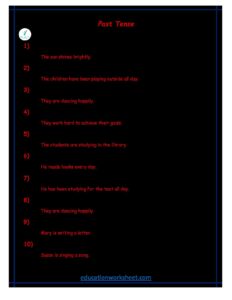how to converting Past Tense negative sentences to interrogative form
how to converting Past Tense negative sentences to interrogative form
Converting past tense negative sentences into interrogative form is a fundamental aspect of English grammar and communication. This transformation allows us to ask questions about past events, actions, or situations where a negative statement has already been made. Understanding how to do this effectively is essential for effective communication and comprehension. In this extensive guide, we will explore various aspects of converting past tense negative sentences to interrogative form, providing you with a comprehensive understanding of the topic.
I. Introduction
Converting past tense negative sentences to interrogative form involves changing the structure and word order of a sentence to turn a negative statement into a question. This transformation is crucial for seeking information, clarifying doubts, or engaging in meaningful conversations. In English, this process is relatively straightforward and can be accomplished by following specific rules and guidelines.
II. Basic Structure
To convert a past tense negative sentence into an interrogative sentence, the following changes are typically made:
- Subject-Auxiliary Inversion: The subject and auxiliary verb switch places. In the case of negative sentences, the auxiliary verb is usually “did.”
- Addition of the Auxiliary Verb “Did:” The auxiliary verb “did” is added at the beginning of the sentence.
- Removal of the Negative Word: The negative word (e.g., “not”) is removed or replaced with a question word (e.g., “why,” “what,” “how”).
Let’s examine each of these changes in more detail.
A. Subject-Auxiliary Inversion
In English, when forming interrogative sentences, the word order of a statement is typically inverted. This means that the subject (the noun or pronoun performing the action) and the auxiliary verb (e.g., “did,” “does,” “is,” “was”) switch positions. For past tense negative sentences, we commonly use “did” as the auxiliary verb.
B. Addition of the Auxiliary Verb “Did”
To create the interrogative form, the auxiliary verb “did” is added at the beginning of the sentence. The choice of auxiliary verb depends on the tense of the original negative sentence. In the case of past tense, “did” is the appropriate choice.
C. Removal of the Negative Word
The negative word in the original sentence, typically “not” or a contraction like “n’t,” is removed or replaced with a question word such as “why,” “what,” “how,” “where,” “when,” or “who.”
III. Examples
Let’s look at some examples to illustrate the conversion of past tense negative sentences into interrogative form:
- Original Negative Sentence: He did not eat breakfast.
Interrogative Form: Did he eat breakfast?
- Original Negative Sentence: They didn’t visit the museum.
Interrogative Form: Did they visit the museum?
- Original Negative Sentence: She was not watching TV.
Interrogative Form: Was she watching TV?
- Original Negative Sentence: I did not finish my homework.
Interrogative Form: Did I finish my homework?
- Original Negative Sentence: We were not at the party.
Interrogative Form: Were we at the party?
IV. Use of Question Words
In addition to the basic structure, using appropriate question words can add depth and context to interrogative sentences. These question words help specify the type of information you seek. Here are some common question words and their usage:
A. Who
- Original Negative Sentence: She didn’t invite anyone to the party.
Interrogative Form: Who did she invite to the party?
B. What
- Original Negative Sentence: He didn’t buy anything at the store.
Interrogative Form: What did he buy at the store?
C. Where
- Original Negative Sentence: They didn’t go to the beach.
Interrogative Form: Where did they go instead?
D. When
- Original Negative Sentence: She didn’t arrive on time.
Interrogative Form: When did she arrive?
E. Why
- Original Negative Sentence: They didn’t finish the project.
Interrogative Form: Why didn’t they finish the project?
F. How
- Original Negative Sentence: He didn’t pass the exam.
Interrogative Form: How did he perform on the exam?
These question words help tailor your interrogative sentence to elicit specific information, making your communication more effective and precise.
V. Contractions
When converting past tense negative sentences into interrogative form, it’s important to note that contractions play a significant role. Contractions are shortened forms of words created by combining two words, typically a subject and a verb or an auxiliary verb and “not.” Understanding how contractions work in both negative and interrogative sentences is crucial for accurate transformation.
A. Negative Contractions
In negative sentences, contractions commonly include “n’t” or “not” with auxiliary verbs or helping verbs. For example:
- Negative Sentence (contraction): They didn’t finish their meal.
- Negative Sentence (full form): They did not finish their meal.
B. Interrogative Contractions
In interrogative sentences, contractions primarily involve the subject and the auxiliary verb. When converting negative sentences to interrogative ones, you need to pay attention to these contractions. For example:
- Original Negative Sentence (contraction): She didn’t come to the party.
- Interrogative Form (contraction): Didn’t she come to the party?
In this case, “didn’t” is a contraction of “did not.”
VI. Verb Agreement
When converting past tense negative sentences to interrogative form, it’s essential to maintain verb agreement. This means ensuring that the verb agrees in tense and number with the subject of the sentence.
A. Singular Subject
- Original Negative Sentence: He did not go to the movies.
- Interrogative Form: Did he go to the movies?
B. Plural Subject
- Original Negative Sentence: They did not attend the conference.
- Interrogative Form: Did they attend the conference?
Verb agreement ensures that your question is grammatically correct and conveys the intended meaning accurately.
VII. Special Cases
While the basic rules for converting past tense negative sentences to interrogative form are consistent, there are some special cases and nuances to consider.
A. Modal Verbs
When dealing with modal verbs such as “can,” “could,” “will,” “would,” “should,” and “might,” the conversion to interrogative form is slightly different. Modal verbs are followed by the base form of the main verb, and the word order changes accordingly. For example:
- Original Negative Sentence: She could not swim.
- Interrogative Form: Could she swim?
B. Continuous Tenses

In continuous tenses (e.g., present continuous, past continuous), the auxiliary verb “be” is used along with the present participle form of the main verb. To convert a negative sentence in the past continuous tense to interrogative form, follow this pattern:
- Original Negative Sentence: They were not playing football.
- Interrogative Form: Were they playing football?
C. Perfect Tenses
Perfect tenses (e.g., present perfect, past perfect) involve the auxiliary verb “have” followed by the past participle form of the main verb. To convert a negative sentence in the past perfect tense to interrogative form, use the following structure:
- Original Negative Sentence: She had not visited the museum.
- Interrogative Form: Had she visited the museum?
D. Compound Sentences
In complex or compound sentences with multiple clauses, you may need to convert only a specific part of the sentence to interrogative form. Pay attention to the clause you are transforming while keeping the overall sentence structure intact. For example:
- Original Negative Sentence (Compound): While he did not attend the conference, she did.
- Interrogative Form (Partial): Did he attend the conference?
VIII. Punctuation
In written English, proper punctuation is essential for clarity and grammatical correctness. When converting past tense negative sentences into interrogative form, you must use a question mark (?) at the end of the sentence to indicate that it is a question.
Example:
- Original Negative Sentence: They did not go to the party.
- Interrogative Form: Did they go to the party?
IX. Contrasting Statements
Sometimes, you may want to create questions that contrast with previous statements or expectations. In such cases, it’s essential to use appropriate question tags. Question tags are short phrases or words added to the end of a sentence to seek confirmation or contrast with a statement.
A. Positive Statement with Negative Question Tag
- Statement: She went to the concert, didn’t she?
- Interrogative Form: Did she go to the concert?
B. Negative Statement with Positive Question Tag
- Statement: He didn’t like the movie, did he?
- Interrogative Form: Did he like the movie?
Question tags add nuance to your questions and are particularly useful in conversational English.
X. Practice Exercises
To reinforce your understanding of converting past tense negative sentences to interrogative form, here are some practice exercises:
Exercise 1: Convert the following negative sentences into interrogative form.
- They didn’t finish their homework.
- Interrogative Form: Did they finish their homework?
- She was not feeling well.
- Interrogative Form: Was she feeling well?
- He did not take the bus.
- Interrogative Form: Did he take the bus?
- We didn’t see the movie.
- Interrogative Form: Did we see the movie?
- They hadn’t visited that place before.
- Interrogative Form: Had they visited that place before?
Exercise 2: Create original negative sentences and convert them into interrogative form.

- Original Negative Sentence: ___________________________________________
- Interrogative Form: _______________________________________________
- Original Negative Sentence: ___________________________________________
- Interrogative Form: _______________________________________________
- Original Negative Sentence: ___________________________________________
- Interrogative Form: _______________________________________________
- Original Negative Sentence: ___________________________________________
- Interrogative Form: _______________________________________________
- Original Negative Sentence: ___________________________________________
- Interrogative Form: _______________________________________________
XI. Conclusion
Converting past tense negative sentences to interrogative form is a fundamental skill in English grammar. It allows for effective communication, question formation, and clarification of information. By following the basic rules and guidelines outlined in this comprehensive guide, you can confidently transform negative statements into meaningful questions. Practice is key to mastering this skill, so continue to work on exercises and engage in conversations to refine your ability to create and understand interrogative sentences in various contexts.
how to converting Past Tense negative sentences to interrogative form Unlock the secrets of converting Past Tense negative sentences into captivating interrogative form. Master the art of crafting meaningful questions and turning the past’s negation into inquiry. Empower your language proficiency and engage in more dynamic conversations with our expert guide. Unleash your potential to create thought-provoking queries and transform the way you communicate about the past. Start reshaping your language skills today and discover the power of positive questioning

